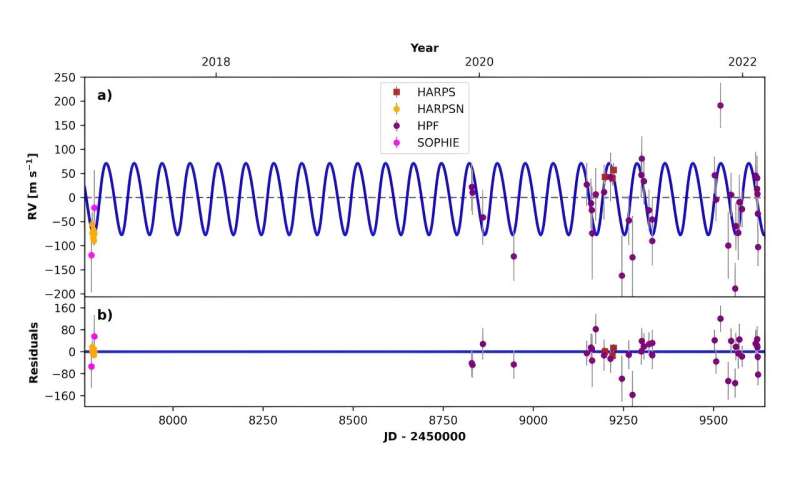March 14, 2024 report
This article has been reviewed according to Science X's editorial process and policies. Editors have highlighted the following attributes while ensuring the content's credibility:
fact-checked
preprint
trusted source
proofread
Warm Jupiter exoplanet orbiting distant star detected

Astronomers report the discovery of a new warm Jupiter exoplanet orbiting a distant star in the open cluster Messier 67. The newfound extrasolar world, designated S1429 b, is almost twice as massive as Jupiter. The finding was detailed in a paper published March 5 on the pre-print server arXiv.
Warm Jupiters are gas giant planets with orbital periods between 10 and 200 days. This makes them challenging targets for transit detection and radial velocity (RV) follow-up studies compared to their shorter-orbit counterparts, dubbed hot Jupiters.
Recently a team of astronomers, led by Luis Thomas of the University Observatory Munich in Germany, have conducted spectroscopic observations of 11 stars in Messier 67 (or M67 for short, dubbed also the King Cobra Cluster)—an old and well-populated Galactic open cluster (OC).
The observational campaign, which employed mainly the Habitable Planet Finder (HPF) spectrograph mounted on the 10m Hobby-Eberle Telescope (HET) at the McDonald Observatory in Texas, was part of the "Search for Giant Planets in M67" RV survey.
"Between December 2019 and March 2022, we continued the observations of 11 stars in M67 with the Habitable Planet Finder spectrograph (HPF). We included six stars that showed potential long-term RV variations and five stars at the turn-off point of M67 which had no previously published data," the researchers wrote in the paper.
The observations performed by Thomas' team resulted in the detection of a new planet around a turn-off point star of spectral type F9.5V known as S1429. The newly found alien world, which received designation S1429 b, is the sixth planet discovered in Messier 67.
According to the paper, S1429 b has a minimum mass of 1.8 Jupiter masses and orbits its host star every 77.48 days on a most likely circular orbit, at a distance of approximately 0.384 AU from it. The equilibrium temperature of the planet was estimated to be about 683 K.
The parent star S1429, located some 2,800 light years away from the Earth, is about two times larger than the sun, while its mass is only 1.26 solar masses. The star is estimated to be 4.3 billion years old, has an effective temperature of nearly 6,000 K, and its metallicity is at a level of -0.013 dex.
Summing up the results, the authors of the paper underlined that the total six known planet-hosting stars in Messier 67, including S1429, are distributed over different evolutionary stages.
In particular, there are three hot Jupiters orbiting main-sequence stars and the longer period planets orbit a turn-off point star and two red giants. They noted that all the three hot Jupiters in this cluster have minimum masses significantly below one Jupiter mass.
More information: Luis Thomas et al, Search for giant planets in M67 V: a warm Jupiter orbiting the turn-off star S1429, arXiv (2024). DOI: 10.48550/arxiv.2403.02911
Journal information: arXiv
© 2024 Science X Network





















